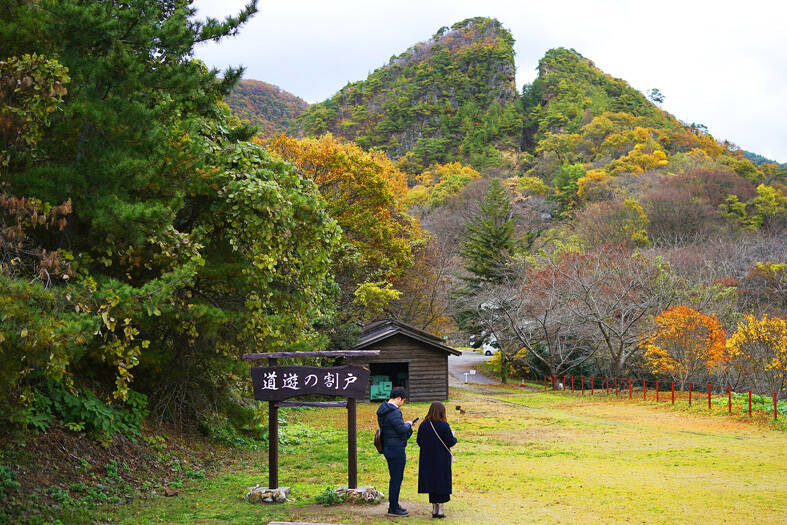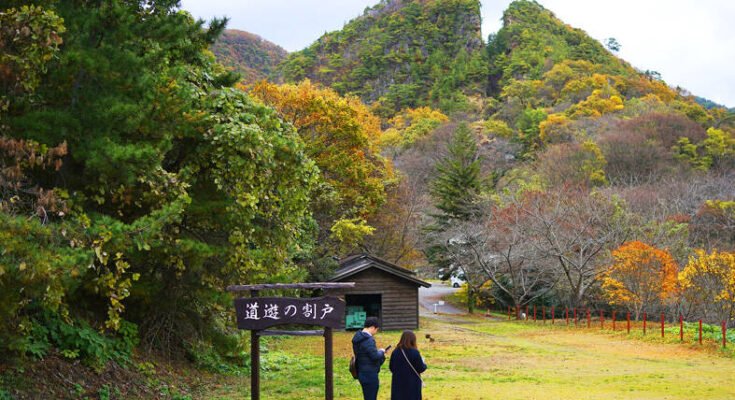AP, SADO, Japan
Japan held a memorial ceremony yesterday near the Sado Island Gold Mines despite a last-minute boycott of the event by South Korea that highlighted tensions between the neighbors over the issue of Korean forced laborers at the site before and during World War II.
South Korea’s absence at the memorial, to which Seoul government officials and Korean victims’ families were invited, is a major setback in the rapidly improving ties between the two countries, which since last year have set aside their historical disputes to prioritize US-led security cooperation.
The Sado mines were listed in July as a UNESCO World Heritage site after Japan moved past years of disputes with South Korea and acknowledged the mines’ dark history, promising to hold an annual memorial service for all victims, including hundreds of Koreans who were mobilized to work in the mines.

Visitors stand near Doyu no Warito, a symbolic relic of the Sado Gold Mine, in Sado, Niigata Prefecture, Japan, yesterday.
Photo: AP
On Saturday, South Korea announced it would not attend the event, saying it was impossible to settle unspecified disagreements between the two governments in time.
Families of Korean victims of the mine incidents were expected to separately hold their own ceremony near the mine at a later date.
Masashi Mizobuchi, an assistant press secretary in the Japanese Ministry of Foreign Affairs, said Japan has been in communication with Seoul and called the South Korean decision “disappointing.”
The ceremony was held yesterday at a facility near the mines, where more than 20 seats for Korean attendees remained vacant.
The 16th-century mines on the island of Sado, off Japan’s north-central coast, operated for nearly 400 years before closing in 1989 and were once the world’s largest gold producer.
Historians say about 1,500 Koreans were mobilized to Sado as part of Japan’s use of hundreds of thousands of Korean laborers, including those forcibly brought from the Korean Peninsula, at Japanese mines and factories to make up for labor shortages because most working-age Japanese men had been sent to battlefronts across Asia and the Pacific.
Japan’s government has maintained that all wartime compensation issues between the two countries were resolved under a 1965 normalization treaty.
South Korea had long opposed the listing of the site as World Heritage on the grounds that the Korean forced laborers, despite their key role in the wartime mine production, were missing from the exhibition. Seoul’s backing for Sado came as South Korean President Yoon Suk-yeol prioritized improving relations with Japan.
The Japanese government yesterday said the ceremony was to pay tribute to “all workers” who died at the mines, but would not spell out the inclusion of Korean laborers — part of what critics have called a persistent policy of whitewashing Japan’s history of sexual and labor exploitation before and during the war.
Japan’s government on Friday said that Japanese lawmaker Akiko Ikuina — who reportedly visited Tokyo’s controversial Yasukuni Shrine in August 2022, weeks after she was elected — would attend the ceremony.
Japan’s neighbors view Yasukuni, which commemorates 2.5 million war dead including war criminals, as a symbol of Japan’s past militarism.
South Korean Minister of Foreign Affairs Cho Tae-yul on Saturday said that Ikuina’s Yasukuni visit was an issue of contention between the countries’ diplomats.
“That issue and various other disagreements between diplomatic officials remain unresolved, and with only a few hours remaining until the event, we concluded that there wasn’t sufficient time to resolve these differences,” Cho said in an interview with MBN television.
Some South Koreans had criticized Yoon’s government for supporting the event without securing a clear Japanese commitment to highlight the experience of Korean laborers.



